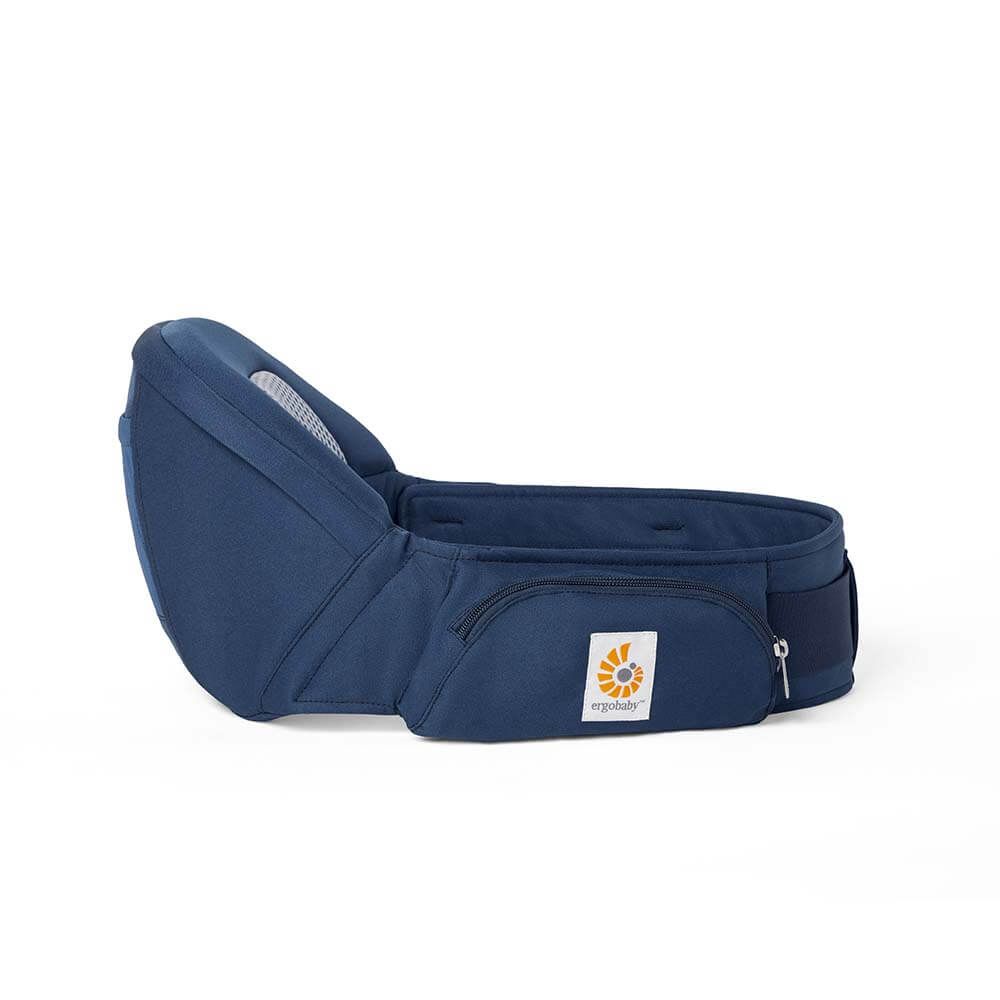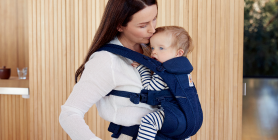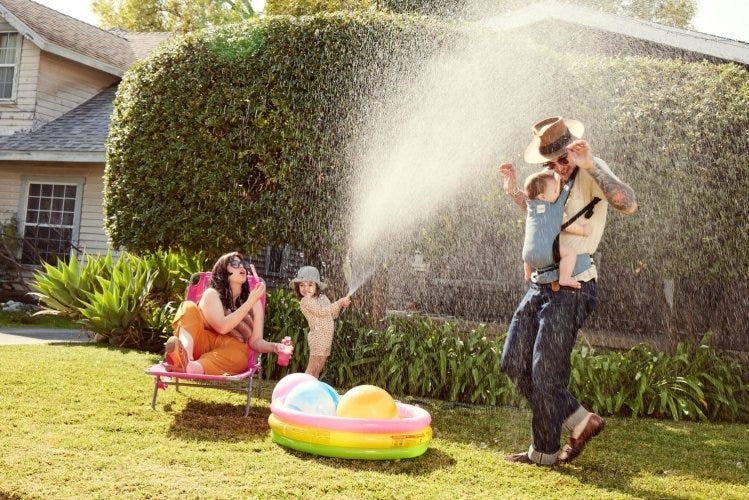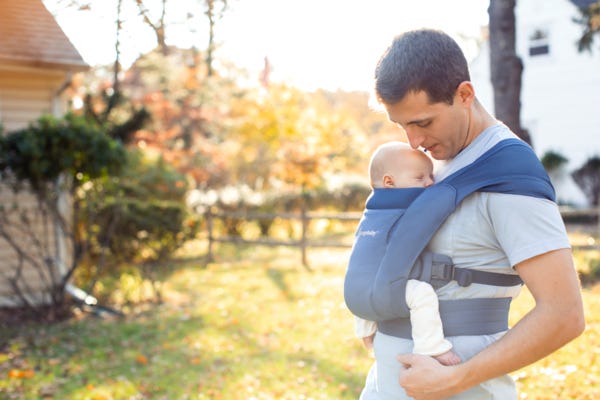
Why You’ll Never Forget That New Baby Smell (And Shouldn’t Try To!)
We have all heard about new car smells, but what about new baby smells? You know, that earthy, new baby smell, that one that causes dopamine to release in your brain and makes you feel so good - what is it? Smell can be the most potent sense to strike up an emotional response.
So, what exactly is that new baby smell?
The smell of a newborn is likely thought to be a combination of chemicals secreted through sweat glands, lingering amniotic fluid and vernix caseosa, the white cheese-like cream that covers babies at birth; all this combined, is thought to create a combination of intoxicating medley aroma that nature designed to pull you in. Whatever it is, that distinct smell provides a pathway to our brains and to ultimately our hearts and binds us to that little life in front of us. Although the newborn scent eventually fades (usually around six weeks of age) many parents (including this one) are known to take a deep whiff of their child’s head (regardless of their age) and savor the unique scent and comfort it provides you.
Delayed Bathing
In the past, many hospital births resulted in baby being bathed and cleaned immediately after birth. This is still policy in some hospitals. However, these days we are beginning to understand why delaying a bath and leaving the vernix on baby is important. The World Health Organization recommends delaying the first bath until at least 24 hours after birth. The longer you wait on the first bath, the better. Delaying the baby and leaving the vernix caseosa intact, helps contribute to that new baby smell, but it also acts as a natural moisturizer and barrier on baby’s skin. Delaying the infant bath allows mother and baby time to bond, allows for skin to skin, and increases the likelihood of initiating breastfeeding. It also keeps that precious vernix where it belongs, on your baby.
Mother / Infant Bond
Studies show that all mammals use their sense of smell to create that mother/infant bond. Not only do we react to baby’s scent, studies also have shown that babies also react to their own parents’ scents. Babies show a preference for clothing worn by their parents, usually if it has the scent of their milk on it. The odor of mother’s breast milk on preterm babies especially seems to have a calming effect and can be used as a safe method for pain relief. According to a 2021 study, “babies are more socially receptive to unfamiliar women when they can smell their mother’s natural body odor, suggesting that maternal scent functions as a safety signal.” This study was done using a t-shirt that mothers were instructed to bring home to sleep with and then return to the test site. Infants that weren’t with their mother, but were with their mother’s t-shirt showed the same receptivity to the stranger they were with that they did with their mother. An additional study “assessed the responsiveness of newborn breast- and bottle-fed infants to presentations of maternal odor. Maternal odor was presented for 1 min to crying, sleeping or awake newborns. The odors were: (1) own mother’s odor - presentation of a hospital gown worn by the baby’s mother, (2) other mother’s odor - presentation of a hospital gown of another newborn baby’s mother, (3) clean gown - presentation of a clean hospital gown and (4) no gown - no gown presented. The results indicated that crying babies stopped crying when either own mother or other mother odor was presented.” Is that amazing?! Scent holds so much power! And it’s one of the reasons that babywearing is such a powerful tool for bonding.
Babywearing and Smell
One of the biggest safety tips for carrying babies is that you keep your little one “close enough to kiss”. But we could also say, keep them close enough to smell! You being able to smell your baby and your baby being able to smell you creates a closeness and a sense of comfort for both caregiver and child. There are so many benefits of babywearing, and being able to cherish that new baby smell in the first few weeks is just the cherry on top. The Embrace Newborn Carrier is a soft, cozy option that keeps baby close—perfect for bonding during those early days.
- Strengthens the bond between parent and baby, as you maintain a closeness throughout your day—especially during the 4th trimester. A newborn carrier like the Embrace supports this connection with soft, snug fabric designed for first cuddles.
- Carried babies cry less. Researchers found that babywearing for three hours a day reduced infant crying by 43 percent overall and 54 percent during evening hours.
- Mothers providing daily skin-to-skin contact to their newborn had significantly lower scores on the depression scales.
- Aids in baby’s development, both physically and emotionally.
- Helps mothers respond to their babies.
- Helps mothers meet their breastfeeding goals.
- Decreases risk of SIDS and flat-head syndrome
- Improves overall maternal physical health (decreased sleep disturbances by 18% and gastrointestinal problems by 26%)*
- Promotes early language development. Babies learn by watching faces, and babywearing puts your little one at conversational height- “the best seat in the house.”
- Allows parents to see more of the world through baby’s eyes. And your babies get to discover their new world from the safety and comfort of your body.
- Fosters a closeness through toddlerhood. Toddlers can be worn too, reminding them of their “home base,” and allowing that bond to continue as they grow.
So get out there and start sniffing it up. The smell will fade but your memory of it will not. And if you’re about to give birth remember what nature intended and the World Health Organization recommends, wait to bathe and enjoy the new baby smell.
Emotional Benefits of Getting Outside
Spending time in nature with your baby can strengthen the bond between you. The simple act of holding your baby close, feeling their warmth, and sharing new experiences together can create strong emotional connections. It’s also a wonderful way to reduce stress and improve your mood. When my littles were extra fussy, I’d take a walk around the neighborhood. Even though I don't live in an area with trails and surrounded by nature, simply behind outside changed everything. A little vitamin D does wonders!
Cognitive Development
Nature is a sensory wonderland for babies. The different sights, sounds, and smells can stimulate your baby’s senses and promote cognitive development. Watching leaves rustle, hearing birds chirp, and feeling the texture of a tree bark can all contribute to their learning and development.
All About Baby Carriers for Nature Adventures
Choosing the Right Baby Carrier
When it comes to selecting the best baby carrier for summer adventures, there are several options to consider.
Types of Baby Carriers:
- Wraps: Perfect for newborns, providing a snug and secure fit.
- Slings: Ideal for quick and easy use, offering good ventilation.
- Soft Structured Carriers: Versatile and comfortable for both parent and baby, suitable for longer trips.
Factors to Consider:
- Baby’s Age and Weight: Ensure the carrier is appropriate for your baby’s size and weight. For example, Ergobaby’s Embrace Newborn Carrier is perfect for the fourth trimester where baby is small and you’re looking for an easy way to stay close. As they grow, you’ll want to upgrade to an all-position carrier that’s meant for growing babies.
- Parent’s Comfort and Ergonomics: Look for carriers with padded shoulder straps and lumbar support if you’re planning on longer outings.
- Ease of Use: Choose a carrier that is easy to put on and take off.
- Climate and Breathability: Opt for carriers made of breathable fabrics to keep you and your baby cool in hot weather.
Safety Tips:
- Proper Positioning: Ensure your baby is seated correctly, with their legs in an "M" position and their head should be close enough to kiss.
- Checking for Wear and Tear: Regularly inspect your carrier for any signs of damage.
- Ensuring Adequate Support: Make sure the carrier provides proper support for your baby’s head and neck.
Exploring Nature with a Baby Carrier
Ideal Spots for a Nature Walk with Baby
- Parks and Gardens: Great for leisurely walks and picnics.
- Nature Trails and Forests: Perfect for more adventurous outings.
- Beaches and Lakesides: Wonderful for enjoying the water and sand, with the right carrier.
Activity Ideas
- Hiking: Enjoy a scenic hike with a hiking baby carrier that offers support and storage.
- Bird Watching: Use your carrier to keep your baby close while you explore and observe wildlife.
- Picnics: A carrier can free up your hands, making it easier to carry picnic supplies.


Advantages of Using Strollers for Nature Adventures
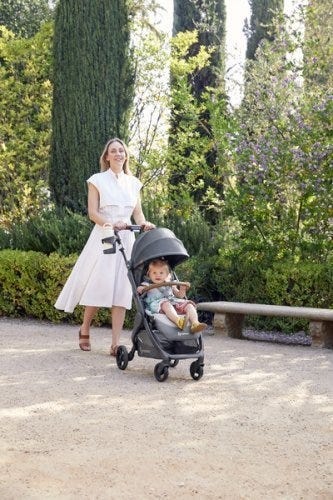

While baby carriers are fantastic for mobility and closeness, depending on the adventure of choice you might want to be a stroller along too.
There are a LOT of baby stroller options on the market. So we understand how confusing it can be to choose the one that’s right for your family. Not only are there a variety of brands, but a variety of strollers that serve different purposes.
There are a few types of strollers on the market:
- Full-sized stroller: This is typically the stroller parents thing of buying for all its versatility.
- Lightweight or umbrella stroller:These compact strollers are perfect for on-the-go adventures.
- Jogging stroller: Designed for parents who want to combine fitness with outdoor adventures.
- Double stroller: Designed for parents with multiple kids, especially twins.
- Car seat carrier: These strollers connect to a specific car seat. We don't typically recommend these as they can be unsafe for baby and uncomfortable for parents who are pushing.
Learn more about the types of strollers and which one would be best for you.
Benefits of Bringing a Stroller
- Storage Space for Gear: Ample room for carrying all your essentials like a diaper bag, beach toys and more.
- Shade and Weather Protection: Built-in canopies to shield your baby from the sun when they are lounging.
- Options: If you have more than one kid, you can stroll with one and carry the other. Or, if you’re getting warm or your little one is getting fussy, you can switch up their position from stroller to carrier or vice versa.
Safety Tips for Strollers
- Ensure your stroller is in good working condition. Make sure buckles are still buckling and that there are no rips or holes that could compromise your baby’s safety.
- Use sunshades or bug nets to protect your little one’s skin.
- Securing the baby properly: always buckle up your baby for safety even if you think they are old enough to go without the buckle.
Combining Baby Carriers and Strollers
For the ultimate flexibility, consider using both a baby carrier and a stroller on your outings.
Combining both options allows you to adapt to different situations. Use the carrier for more rugged trails and switch to the stroller for smoother paths or when your baby needs a nap.
Transition Tips
- Smooth Transitions: Plan stops where you can easily switch from carrier to stroller.
- Pack Light: Only bring essentials to make transitions easier.
Tips for a Successful Adventure
Planning Ahead
- Route Planning: Choose baby-friendly trails and parks. Check local mom groups or outdoor groups and get recommendations for the best outings for kids.
- Check Weather Conditions: Avoid extreme heat or unpredictable weather. Even with our most breathable carriers, when it’s hot, it’s hot. And having two bodies against each other in the heat will be naturally hot and sticky already.
- Packing Checklist: Include diapers, snacks, water, sunscreen, and a first-aid kit. These all-position carriers have storage pockets where you can fit some of the items easily!
- Stay Hydrated and Nourished: Pack healthy snacks to keep energy levels up and bring plenty of water for both you and baby.
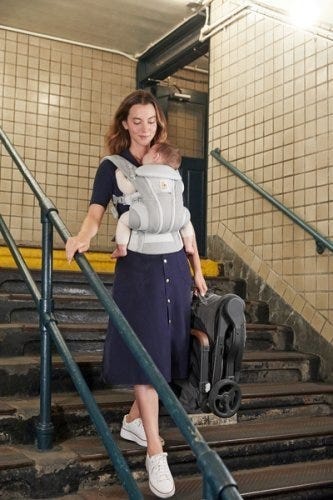

Summer adventures with your baby are a wonderful way to create lasting memories and enjoy the beauty of nature together. From baby carriers to strollers, Ergobaby products are designed to provide comfort and ease for both you and your little one. So, gear up, get outside, and explore the world with your baby by your side.
Ready to embark on your own summer adventures? Check out Ergobaby’s range of baby carriers and strollers to find the perfect match for your family’s needs. Visit our website today and start planning your next outdoor excursion!





